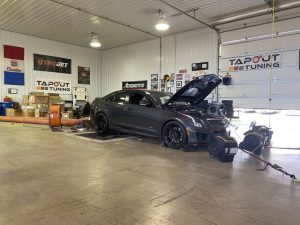Our good friend Paul from Ohio was the first ever ATS-V to run nine second quarter mile passes in the new ‘True Street’ category. He was slightly under the 3,950 pound minimum weight requirement, so he actually had to add ballast in his trunk that day. But like most of us, Paul always wants a little more. So our team installed Mace Stage 1 valve springs, titanium retainers and camshafts and strapped this car back on the dyno. The results turned out to be almost exactly what we expected. The engine made a little less horsepower and torque below 4,800 rpm. The power gains started at 5,300 rpm, and kept increasing as engine speed rose.
How much were the gains? If you make the common mistake of only considering peak numbers, all you’ll notice is the fact that power increased from 638 to 640 whp, which is statistically insignificant. Instead, look the graph at 6,000 rpm and you’ll see 10 more whp. At 6,500 the gain was 20 whp. And at 7,000 rpm it’s typically 30 whp (although we failed to spin the engine that high on our baseline pull). These are significant gains that can be felt driving the car, and will produce real results both on the street and at the track.
But wait a minute? Does this mean the car is now slower, since it has less bottom end power than it did before? Not at all. Once you consider the fact that the engine speed is nearly always above 5,500 rpm at WOT, you realize that any time you’re at full throttle with these cams, your engine will now be producing more power! 